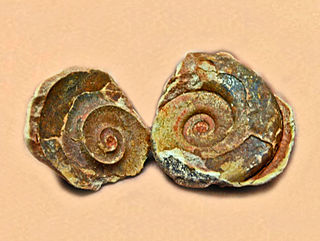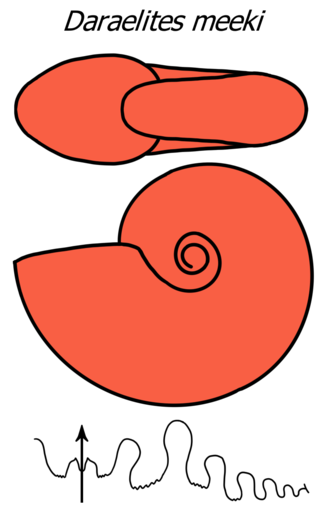
Ammonitida or "True ammonites" are an order of ammonoid cephalopods that lived from the Jurassic through Paleocene time periods, commonly with intricate ammonitic sutures.

Xenodiscus is an extinct genus of ammonoid cephalopod and one of the earliest known ceratites, found in the Upper Permian of northern India and Timor. Xenodiscus is included in the family Xenodiscidae which is part of the ceratite superfamily Xenodiscaceae.
Anderssonoceras is a genus of small, smooth ammonites with a flared umbilical shoulder, like Prototoceras, assigned to the ceratitid family Anderssonoceratidae as the type, but once included in the Otoceratidae.

Ceratitida is an order that contains almost all ammonoid cephalopod genera from the Triassic as well as ancestral forms from the Upper Permian, the exception being the phylloceratids which gave rise to the great diversity of post-Triassic ammonites.
Noritoidea, formerly Noritaceae, is an extinct superfamily of cephalopods belonging to the Ammonite order Ceratitida.

The Xenodiscidae are the earliest of the Ceratitida and comprise Middle and Upper Permian genera characterized by compressed, discoidal, evolute shells with rounded to acute venters and commonly with lateral ribs. Sutures are goniatitic to weakly ceratitic.
Xenoceltitidae are evolute, generally ribbed, upper Lower Triassic Ceratitida with ceratitic or goniatitic sutures; formerly included in the Noritaceae but now placed in the Xenodiscaceae.
Thalassoceratidae a family of late Paleozoic ammonites included in the goniatitid superfamily Thalassoceratoidea along with the Bisatoceratidae. Some eight genera are included, although the specific number and exactly which depends on the particular classification.

Prolecanitida is an order of extinct ammonoid cephalopods, the major Late Paleozoic group of ammonoids alongside the order Goniatitida. Prolecanitids had narrow shells, discoidal (disc-shaped) to thinly lenticular (lens-shaped). They retained a retrochoanitic siphuncle, a simple form with septal necks extending backwards. As is typical for ammonoids, the siphuncle sits along the ventral margin of the shell.
Ancyloceratoidea, formerly Ancylocerataceae, is a superfamily of typically uncoiled and loosely coiled heteromorph ammonoids established by Alpheus Hyatt in 1900, that may contain as many as 11 families, depending on the classification accepted.
The Ophiceratidae is a family in the ammonoid order Ceratitida from the Lower Triassic, previously included in the Otocerataceae but now placed in the Noritiaceae as revised.

The Daraelitidae form a family in the ammonoid order Prolecanitida from the Upper Mississippian - Middle Permian characterized by discoidal shells with no prominent sculpture, moderately large umbilicus, and goniatitic or ceratitic sutures with a trifid ventral lobe and few auxiliary lobes.
Clydonitoidea, formerly Clydonitaceae, is a superfamily in the ammonoid cephalopod order Ceratitida characterized by generally costate and tuberculate shells with smooth, grooved, or keeled venters and sutures that are commonly ceratitic or ammonitic but goniatitic in a few offshoots.
Ceratitoidea, formerly Ceratitaceae, is an ammonite superfamily in order Ceratitida characterized in general by highly ornamented or tuberculate shells with ceratitic sutures that may become goniatitic or ammonitic in some offshoots.

Stephanoceratoidea, formerly Stephanocerataceae, is a superfamily of middle- upper Jurassic ammonoid cephalopods within the order Ammonitida containing diverse forms, generally with sharp ribbing and complex suture lines. Aptychi are believed to be mostly granular (Granulaptycus) or concentrically ribbed on the surface (Praestriaptychus)
The Tropitidae is a family of Upper Triassic Ammonoidea belonging to the Tropitoidea, a superfamily of the Ceratitida

Hildoceratidae is a family of ammonoid cephalopods from the Lower Jurassic, lower Pliensbachian to lower Bajocian substages, generally with strongly ribbed, involute shells. They are combined with the Hammatoceratidae, Graphoceratidae, and Sonniniidae to make up the Hildoceratoidea.
Olenekoceras is an ammonoid cephalopod from the Lower Triassic included in the ceratitid family Sibiritidae, once included in the Noritaceae but now in the Ceratitaceae.

Ophiceras is an extinct genus of smooth, evolute ceratitid ammonites from the Griesbachian, with a rounded venter. Fossils of the genus have been found in Armenia, Azerbaijan, China, Greenland, and India.

Meekoceras is an extinct genus of ceratitid ammonites with a discoidal shell that lived during the Early Triassic Epoch.










